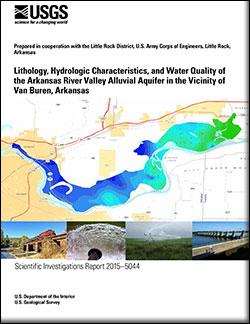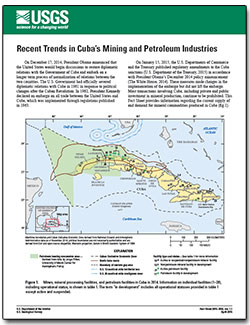Filters: Types: OGC WMS Service (X) > Categories: Publication (X)
622 results (13ms)|
Filters
Date Range
Extensions Types Contacts
Categories Tag Types
|
Description: The upper Gila River in New Mexico is one of the few unobstructed rivers in the Colorado River Basin with largely intact native fish populations, including four federally listed and one state listed species.Freshwater systems throughout the West continue to be threatened by human encroachment and water development. Methodologies or decision support tools to evaluate resource management practices that foster an understanding of how fish species adapt to the effects of climate change are critical to future resource management planning.
Categories: Data,
Publication;
Types: Citation,
Map Service,
OGC WFS Layer,
OGC WMS Layer,
OGC WMS Service;
Tags: 2011,
AZ-01,
AZ-02,
Academics & scientific researchers,
Applications and Tools,
Watersheds draining the Arctic Coastal Plain (ACP) of Alaska are dominated by permafrostand snowmelt runoff that create abundant surface storage in the form of lakes, wetlands, and beaded streams. These surface water elements compose complex drainage networks that affect aquatic ecosystem connectivity and hydrologic behavior. The 4676 km2 Fishand Creek drainage basin is composed of three watersheds that represent a gradient of theACP landscape with varying extents of eolian, lacustrine, and fluvial landforms. In each watershed, we analyzed 2.5-m-resolution aerial photography, a 5-m digital elevationmodel, and river gauging and climate records to better understand ACP watershed structureand processes. We show that...
Stream fragmentation alters the structure of aquatic communities on a global scale, generally through loss of native species. Among riverscapes in the Great Plains of North America, stream fragmentation and hydrologic alteration (flow regulation and dewatering) are implicated in the decline of native fish diversity. This study documents the spatio–temporal distribution of fish reproductive guilds in the fragmented Arkansas and Ninnescah rivers of south-central Kansas using retrospective analyses involving 63 years of fish community data. Pelagic-spawning fishes declined throughout the study area during 1950–2013, including Arkansas River shiner (Notropis girardi) last reported in 1983, plains minnow (Hybognathus...
Categories: Data,
Publication;
Types: Citation,
Map Service,
OGC WFS Layer,
OGC WMS Layer,
OGC WMS Service;
Tags: CATFISHES/MINNOWS,
Colorado,
Colorado,
FISH,
Federal resource managers,
Habitat fragmentation and flow regulation are significant factors related to the decline and extinction of freshwater biota. Pelagic-broadcast spawning cyprinids require moving water and some length of unfragmented stream to complete their life cycle. However, it is unknown how discharge and habitat features interact at multiple spatial scales to alter the transport of semi-buoyant fish eggs. Our objective was to assess the relationship between downstream drift of semi-buoyant egg surrogates (gellan beads) and discharge and habitat complexity. We quantified transport time of a known quantity of beads using 2–3 sampling devices at each of seven locations on the North Canadian and Canadian rivers. Transport time was...
We used the United States National Grid to develop a sampling grid for monitoring programs in the Great Plains Landscape Conservation Cooperative, delineated by Bird Conservation Regions 18 and 19. Landscape Conservation Cooperatives are science based partnerships with the goal to inform and guide conservation at regional landscape levels. Developing a standardized sampling grid for a LCC is a new endeavor and is designed to reduce program costs, avoid repetition in sampling, and increase efficiency in monitoring programs. This is possible because the grid’s nationwide coverage, uniform starting point, and scalability allow researchers to expand their monitoring programs from a small, local level to a regional or...
Categories: Data,
Publication;
Types: Citation,
Map Service,
OGC WFS Layer,
OGC WMS Layer,
OGC WMS Service;
Tags: BIRDS,
Colorado,
Colorado,
Federal resource managers,
Final Report,

Categories: Publication;
Types: Citation,
Map Service,
OGC WFS Layer,
OGC WMS Layer,
OGC WMS Service;
Tags: Scientific Investigations Report
The dwarf shrew (Sorex nanus) is one of the smallest mammals in the world, and inhabits a variety of habitats in western North America. Very little is known about this shrew, and relatively few specimens have been collected. Like most members of Soricidae, the dwarf shrew has a long and pointed nose, small eyes and ears, and a small body. It is difficult to distinguish from other shrews and generally has to be identified by dental characteristics. The dwarf shrew occurs primarily in mountainous areas, apparently preferring rock outcrops and talus slopes in alpine, subalpine, and montane settings. However, it has been occasionally found in lower and more arid environments such as shortgrass prairie, shrub-steppe,...
Categories: Publication;
Types: Map Service,
OGC WFS Layer,
OGC WMS Layer,
OGC WMS Service;
Tags: BLM,
WLCI,
WLCI Agency Report

Categories: Publication;
Types: Citation,
Map Service,
OGC WFS Layer,
OGC WMS Layer,
OGC WMS Service;
Tags: Fact Sheet
As part of the Long Term Resource Monitoring Program (LTRMP) macroinvertebrate component, historical sites (sites where benthic samples were previously collected by other researchers) were sampled in 1992 through 1998. Historical data on densities of the taxa were obtained from published literature and compared to data collected by the LTRMP. Temporal trends and spatial distribution in the abundance of mayflies (Ephemeroptera) and fingernail clams (Sphaeriidae) were examined in Navigation Pools 4, 8, 13, 26, and the Open River reach of the Mississippi River and La Grange Pool of the Illinois River.
Many aquatic snails occupy ephemeral habitats that are occasionally subjected to severe environmental conditions. To investigate the physiological capacity of these animals to resist extreme environmental changes, we aerially exposed pond snails (Physella integra) to temperatures of 5�C and 20�C for 6, 8, 12, 24, 36, 48, and 60 hours. Survivorship varied with temperature and exposure times. At 20�C, survivorship was 0% for snails aerially exposed for 24 hours or longer. At 5�C, 0% survivorship was attained at 60 hours exposure. Sensitivity to aerial exposure was related to shell size of individuals, with larger specimens (shell length greater than 7 mm) significantly more likely to survive exposure than smaller...
This manual is based on the Geographic Resources Analysis and Statistical System (GRASS) version 4.0 running on a Sun SPARC workstation. All the commands described in this manual (GRASS or UNIX) can be used from within GRASS. There is no need to exit GRASS but use of other command tool windows may increase work speed. The user must be in GRASS to execute GRASS-oriented shellscripts.
Eighteen species of native unionid mussels (Unionidae) were recovered from sediments dredged from behind a coffer dam built during the construction of the Melvin Price Lock and Dam on the Upper Mississippi River. For three species (Amblema plicata, Anodonta grandis, and Obliquaria reflexa), shells in the dredged material were significantly smaller than those of the same species collected at about the same time from the other sites in Pool 26 of the Illinois and Mississippi Rivers. The concentration of juvenile specimens in the dredged material is thought to represent a de novo development associated with silt accumulation behind the coffer dam.
This paper presents the research results of statistical parameters associated with turbulence in a natural river caused by the movement of navigation traffic. Movement of navigation traffic within restricted inland waterways, such as the Illinois, Mississippi, or Ohio Rivers, changes their flow characteristics temporarily in space and time. These spatial and temporal changes must be quantified in order to assess their efforts on biologically sensitive areas, and they have seldom been evaluated for natural waterways. Data are collected from the Illinois River to evaluate these changes. The longitudinal and lateral components of fluctuating velocity, Reynolds stress, turbulent intensities, turbulent kinetic energy,...
Larval fish were sampled with plankton nets at two backwater and two main channel stations in Pool 8 in 1990, and at one main channel and one backwater station in Pools 8 and 14 in 1989 (four stations each year). Growth of sunfish (Lepomis spp.) and freshwater drum (Aplodinotus grunniens) was estimated with a length-based method and an otolith-based method. For each method, instantaneous mortality was estimated by regressing the natural logarithm of fish catch for each 1-mm size group against the group's estimated age. For freshwater drum, length-based and otolith-based estimates of mortality were similar at three of four main channel stations. However, for larval sunfish, the otolith-based method provided more...
In March 1988 the Long Term Resource Monitoring Program requested that scopes of work be developed for three problems: sedimentation, navigation effects, and water level fluctuations. After consultations with two prominent plant ecologists, Dr. John Barko, U.S. Army Corps of Engineers Environmental Laboratory, and Dr. John Titus, Southern University of New York, a scope of work was prepared outlining a study to determine concentrations of suspended solids limiting aquatic plant growth on the Upper Mississippi River. All work tasks were then prioritized by the Long Term Resource Monitoring Program's Problem Solving Work Group. This scope of work was recommended for funding, however, the timeframe for initiation of...
Categories: Publication;
Types: Map Service,
OGC WFS Layer,
OGC WMS Layer,
OGC WMS Service;
Tags: Publication
During 1990, the fisheries component of the Long Term Resource Monitoring Program (LTRMP) conducted standardized sampling in Pools 4, 8, 13, and 26 of the Upper Mississippi River and La Grange Pool of the Illinois River. Fixed sampling sites from up to nine habitat classes were surveyed by seining, small "minnow" fyke netting, electrofishing, fyke netting, and hoop netting during two fish community sampling time periods (June 25 to August 3 and August 1 to September 17) and three special efforts to sample black crappie Pomoxis nigromaculatus, channel catfish Ictalurus punctatus, and sauger Stizostedeon canadense. A backwater and impounded habitat species complex characterized by bullhead minnow Pimephales vigilax,...
Movement of river traffic such as tows, barges, or recreational craft in navigable rivers and streams can temporarily alter the hydraulic characteristics of the river cross section. These changes may include bow, stern, or transverse waves; resuspension of bed sediments; changes in velocity structures either in close proximity to the moving vessel or within the water body; altered flow direction; and transport of sediment and water into side channels, sloughs, or backwater lakes. Research is being conducted at the Illinois State Water Survey to determine and evaluate the changes that may accompany the movement of river traffic within the Upper Mississippi River System (UMRS). The UMRS extends from Cairo, Illinois,...
In 1989, the Missouri Conservation Commission approved the Streams for the Future program designed to slow stream degradation and enhance and improve streams and corridors. Basin planning was developed to gather baseline hydrological, geomorphological, and biological information on the state's major stream basins. In 1987, the Fox River Basin was surveyed to assess stream habitat and fish communities. Data from the survey and information assimilated from the literature were used to develop this basin plan. The Fox River Basin drains 400 mi2 in northeastern Missouri and southeastern Iowa upstream of the gage station on the Fox River at Wayland, Missouri. The Fox River is a tributary to the Mississippi River. Approximately...
|

|